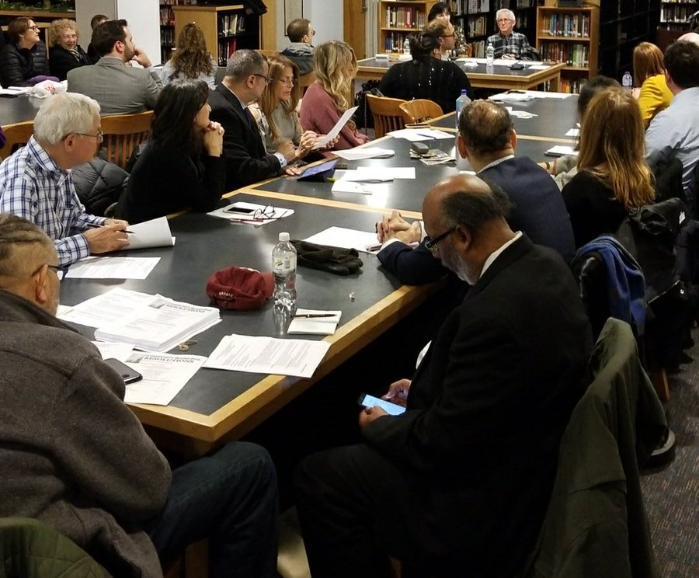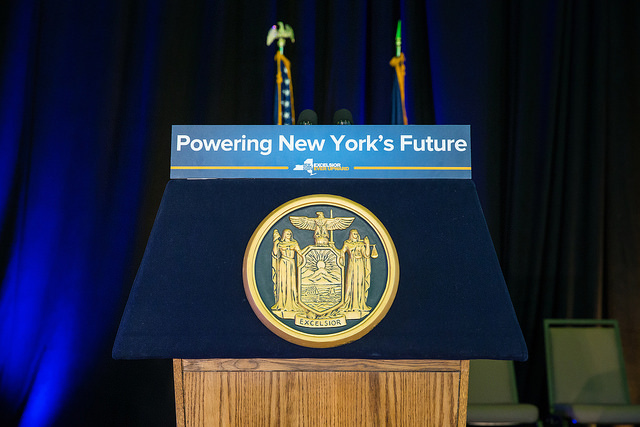Term Limits and Other Community Board Reforms Strengthen Local Democracy

A Manhattan community board meeting (photo: @ManhattanCB5)
Community boards are our most participatory, hyper-local form of government in New York City. In November, we will have the chance to vote for necessary reforms that will help ensure our community boards represent the diverse perspectives of our communities. These reforms will likely include term limits for community board members, greater transparency in the appointment process, and better technical assistance for community board members to make fully informed decisions. They will be put before voters as a result of Mayor de Blasio’s Charter Revision Commission; exact ballot language is due early next month.
As a member of my own Community Board 2 in Queens since April 2017, I have seen the need to open up our community boards, and I urge you to support these measures in November.
Our community boards play a crucial role in shaping the development of our neighborhoods, advising elected officials and agencies on the delivery of city services, and communicating with the broader community at large. To that end, it is crucial that community board membership look, feel, and think with the diverse perspectives that make up each community. It is essential that people of varied backgrounds -- professional, racial, ethnic, and otherwise -- are able to represent their neighborhoods.
Term limits, while not a panacea for better board representation, will help ensure that turnover on the community boards ushers in diverse voices that too often get crowded out when there aren’t many vacancies on boards. True diversity and genuine community representation on community boards can contribute to better city services. After all, community boards whose membership consists of a more holistic cross-section of the community will be in a better position to accurately advise city agencies and local elected officials on the efficacy of city services and additional needs that exist throughout a given community board district.
Board members who are term-limited, as I hope to be one day, can continue to serve in other vital capacities: civic associations, parks conservancies, tenant groups, are just a few of the ways that everyone in the community can participate. This is, of course, in addition to attending community board meetings and speaking at the public comment section, which is open to everyone, including former board members.
The appointment process itself is also in dire need of reform. Board applications should ask not just for character references and organizational affiliation, but also ask applicants about their community knowledge, overall civic participation, and other skills that will be valuable to the boards. This allows board members to be appointed who may not have ties to political offices or previous knowledge about the complex application process. Further, community board membership should be evaluated to assess for diversity among members. Boards that reflect the communities they serve will be stronger and more robust, able to accomplish more for our neighbors.
We also need better technical assistance on the boards to help make objective, thoughtful decisions and requests when crucial issues come before us. This is especially true on matters of public safety and critical land use decisions.
Community boards serve an important purpose. Board members hold city agencies and locally elected officials accountable to local needs. From sidewalk cafes to bike lanes to liquor licenses, community boards touch on everyday life for all New Yorkers. That’s why it’s so critical to open up the process of applying to the community board, and make sure that borough presidents and City Council members place a premium on selecting board members from a broader swath of the community. Join me in November to support these reforms.
***
Jeremy Rosenberg is a community activist, attorney, and member of Community Board 2 which serves Sunnyside,Woodside, and Long Island City. Reach him on Twitter at @jeremyr1992.
***
Have an op-ed idea or submission for Gotham Gazette? Email This email address is being protected from spambots. You need JavaScript enabled to view it.
Why We Wore ‘Abolish ICE’ Shirts to the Statue of Liberty

the author, Tiffany Huang, and her partner (photo: Sy Klipsch-Abudu of NYCLU)
Two months ago, my partner gifted me tickets for a Statue of Liberty tour. Despite growing up near New York and living in the city for the last two years, I had yet to visit the statue itself, and was excited to make the trip. For me and many others, the Statue of Liberty is a symbol of welcome to immigrants and refugees to the United States.
As our July tour date approached, however, the news roiled with ever-more-horrifying reports about family separation and child detention, brought about by the Trump administration’s “zero-tolerance” immigration policy. These horrors were fresh, but not altogether new. Although the United States has indeed served as a beacon of welcome and refuge for many immigrants over the centuries, it has not always lived up to that ideal. From the Chinese Exclusion Act of 1882, to the (anti-immigration) Immigration Act of 1924, to Operation Wetback in the 1950s, this country has at times enacted ugly, racist policies that excluded people from the U.S. on the basis of race and national origin.
We are in the midst of one of those periods. Under the Trump administration, Immigration and Customs Enforcement (ICE) has become an agent of toxic anti-immigrant action. Their “zero-tolerance” policy has led to human rights abuses that have horrified onlookers both in the U.S. and around the world. While the Trump administration has since ended the practice of family separation, more than 500 children remain separated from their families. ICE has deported 460 parents without their children. The trauma that these families have experienced will endure far past this moment.
When we were preparing to go on our Statue of Liberty tour, we felt compelled to raise attention to the contradiction between what the statue symbolizes and the reality of our present politics. We therefore chose to wear shirts that read “Abolish ICE.” For us, “Abolish ICE” is a call to acknowledge the abuses of current immigration policy, and to rebuild our broken immigration system.
When we arrived at the tour’s embarkation point, however, security personnel stopped us and demanded that we either change our shirts, or leave the tour. Although we insisted that we had no plans for disruptive action -- and indeed, we did not -- they held firm. We opted to leave the tour, but later contacted the New York Civil Liberties Union (NYCLU) about the incident. The National Park Service has since admitted that it was a mistake to bar us from the tour because of our shirts, which were simply and obviously an expression of free speech.
We are grateful that the U.S. Park Police has acknowledged its error. But to us, the bigger story is the injustice that the Trump administration continues to perpetrate on immigrant communities. As the Statue of Liberty stands in the New York Harbor, we as a nation must stand up for what she symbolizes.
***
Tiffany J. Huang is a graduate student at Columbia University. On Twitter @tiffjhuang.
***
Have an op-ed idea or submission for Gotham Gazette? Email This email address is being protected from spambots. You need JavaScript enabled to view it.
Unraveling the New York Nuclear Subsidy Scam

(Photo via the Governor's Office)
Across the country, nuclear plant owners are insisting states and the federal government approve billion-dollar subsidies to bail them out -- even if they’re profitable. In its 2016 Clean Energy Standard (CES), the New York State Public Service Commission quietly authorized charging ratepayers up to $7.6 billion over 12 years on their electric bills to subsidize nuclear giant Exelon, so it would keep running upstate nuclear plants it threatened to close (FitzPatrick, Ginna, and Nine Mile Point). Since these surcharges kicked in last spring, New Yorkers have already handed over $656 million and counting to prop up these failing nuclear plants.
The nuclear subsidy scam started in New York, and it's getting exported. After they were imposed here, Exelon and other nuclear owners used the same playbook to obtain billions more in subsidies in Illinois ($2.4 billion), New Jersey ($3.6 billion), Connecticut (estimated up to $3 billion), and soon, Pennsylvania and other states. They did it by falsely claiming their nuclear plants are “clean energy” and “zero emissions,” and threatening to shutter them and terminate their workers if they don’t get the money, escalating their lobbying activity all the while.
Such tactics shouldn’t work, yet they do. For example, in New Jersey Exelon and PSEG threatened to close plants and spent a combined $2.6 million last year on lobbyists, who kept dogging the New Jersey legislature until the unpopular subsidy package finally passed.
To date, the fairness and legality of these subsidies have not been challenged and judged in court. But that’s about to change. A suit in New York State Supreme Court (Matter of Hudson River Sloop Clearwater v. NYS Public Service Commission, Albany County, 7242-16) is finally examining whether these subsidies are illegal or improper, if they violate the public trust and due process of law, and if PSC overstepped its authority by granting them without due process. The suit, of which I am a plaintiff, survived motions to dismiss, and hearings are pending which will have far-reaching implications.
New York is where the nuclear subsidy trend started. The PSC sold subsidies as a way to preserve jobs and “carbon-free” power as a kind of radioactive “bridge” to developing renewables. Now the New York State Supreme Court could be where those specious arguments unravel.
Dirty, obsolete nuclear plants are neither “clean energy” nor “zero emissions” and don’t deserve “zero emissions credits.” Subsidizing them squanders billions that won’t be invested in renewables or efficiency, the two best ways to lower greenhouse emissions and fight climate change. In its first year, New York’s Clean Energy Standard spent 99.5% of its money to subsidize nuclear plants, and just 0.5% on renewables.
Nuclear subsidies aren’t a public good, but a private wealth transfer, enriching wealthy nuclear owners at ratepayers’ expense. As Illinois subsidies kicked in this year, Exelon Generations’ earnings growth shot from 8% to a cork-popping 36%. In New Jersey, the Salem and Hope Creek nuclear plants obtained ratepayer subsidies, yet they’re profitable and will remain so at least through 2021. Nuclear owner PSEG’s CEO admitted to The Bergen Record the subsidy was calculated to guarantee an 18% profit -- almost double the average return for a regulated utility in New Jersey.
Could it be that behind such greedy profiteering is an enlightened desire on the part of nuclear owners to save us from climate change or preserve local jobs and tax bases? Is it unfair to accuse them of ratepayer money grabs?
Hardly. A March 2017 presentation by a former Exelon lobbyist that recently resurfaced brags about its nuclear subsidies representing a huge return on its “investment” in lobbying and political influence. One slide asked rhetorically, “Is Politics Profitable?,” and answers by comparing Exelon’s outlays in New York for the FitzPatrick plant, capital expenditures, and lobbying and PR campaigns to the $7.6 billion it got back in subsidies. It boasts that represented a “return on investment” of 750%. An image on the slide showed copious amounts of cash spiraling down a vortex.
That image is emblematic of what’s wrong with these subsidies: lobbying and politicking for profit, dumping billions in ratepayers’ money down the drain to enrich wealthy plant owners, instead of investing in renewables and efficiency. Those are the real issues, and as the New York State Supreme Court lawsuit goes to trial this year, they will finally get heard.
***
Tim Judson is the Executive Director of the Nuclear Information and Resource Service (NIRS), one of the plaintiffs in the New York lawsuit.
***
Have an op-ed idea or submission for Gotham Gazette? Email This email address is being protected from spambots. You need JavaScript enabled to view it.




